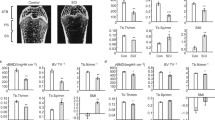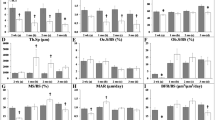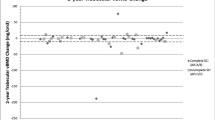Abstract
Spinal cord injury (SCI) results in a great decline in bone mineral density (BMD) and deterioration of bone microarchitecture. The objective of this study was to investigate the time course of the changes in BMD, microarchitecture, biomechanical properties, and bone turnover in male growing rats following SCI. Sixty male growing Sprague-Dawley rats, 6 weeks of age, were randomly divided into SCI (lower thoracic cord transection) and sham-operated groups, and bone tissues and blood samples were examined at 3 weeks, 6 weeks, and 6 months after surgery. SCI rats had low bone weight (wet, dry, and ash weight) and BMD of the femora, tibiae, and third lumbar vertebrae at all time points compared to sham rats, while in forelimbs, there was a decrease of dry and ash weight compared to sham rats only at 3 weeks but not BMD. Bone microarchitecture and trabecular connectivity were deteriorated in SCI rats and remained so after. Bone formation rate and serum osteocalcin level in SCI rats were significantly increased 3 weeks after SCI surgery. However, eroded surface/bone surface and serum N-terminal telopeptide of type I collagen level remained elevated from 3 weeks to 6 months. In addition, SCI rats showed poor biomechanical properties in the proximal tibiae and femora but not in the humeri. In conclusion, SCI causes profound BMD loss, disturbances in bone microarchitecture, decreased mechanical strength in the lower extremity and lumbar spine, and high bone turnover. These findings will allow better understanding of osteoporosis following SCI.


Similar content being viewed by others
References
Frey-Rindova P, de Bruin ED, Stussi E, Dambacher MA, Dietz V (2000) Bone mineral density in upper and lower extremities during 12 months after spinal cord injury measured by peripheral quantitative computed tomography. Spinal Cord 38:26–32
Hill EL, Martin RB, Gunther E, Morey-Holton E, Holets VR (1993) Changes in bone in a model of spinal cord injury. J Orthop Res 11:537–547
Warden SJ, Bennell KL, Matthews B, Brown DJ, McMeeken JM, Wark JD (2002) Quantitative ultrasound assessment of acute bone loss following spinal cord injury: a longitudinal pilot study. Osteoporos Int 13:586–592
Modlesky CM, Majumdar S, Narasimhan A, Dudley GA (2004) Trabecular bone microarchitecture is deteriorated in men with spinal cord injury. J Bone Miner Res 19:48–55
Ragnarsson KT, Sell GH (1981) Lower extremity fractures after spinal cord injury: a retrospective study. Arch Phys Med Rehabil 62:418–423
Ingram RR, Suman RK, Freeman PA (1989) Lower limb fractures in the chronic spinal cord injured patient. Paraplegia 27:133–139
Comarr AE, Hutchinson RH, Bors E (1962) Extremity fractures of patients with spinal cord injuries. Am J Surg 103:732–739
Leblanc AD, Schneider VS, Evans HJ, Engelbretson DA, Krebs JM (1990) Bone mineral loss and recovery after 17 weeks of bed rest. J Bone Miner Res 5:843–850
Kiratli BJ, Smith AE, Nauenberg T, Kallfelz CF, Perkash I (2000) Bone mineral and geometric changes through the femur with immobilization due to spinal cord injury. J Rehabil Res Dev 37:225–233
Takata S, Yasui N (2001) Disuse osteoporosis. J Med Invest 48:147–156
Uebelhart D, Demiaux-Domenech B, Roth M, Chantraine A (1995) Bone metabolism in spinal cord injured individuals and in others who have prolonged immobilisation. A review. Paraplegia 33:669–673
Garland DE, Adkins RH, Kushwaha V, Stewart C (2004) Risk factors for osteoporosis at the knee in the spinal cord injury population. J Spinal Cord Med 27:202–206
Jiang SD, Jiang LS, Dai LY (2006) Spinal cord injury causes more damage to bone mass, bone structure, biomechanical properties and bone metabolism than sciatic neurectomy in young rats. Osteoporos Int 17:1552–1561
Huang TH, Lin SC, Chang FL, Hsieh SS, Liu SH, Yang RS (2003) Effects of different exercise modes on mineralization, structure, and biomechanical properties of growing bone. J Appl Physiol 95:300–307
Alcock N, Macintyre I, Radde I (1960) The determination of magnesium in biological fluids and tissues by flame spectrophotometry. J Clin Pathol 13:506–510
Huang TH, Yang RS, Hsieh SS, Liu SH (2002) Effects of caffeine and exercise on the development of bone: a densitometric and histomorphometric study in young Wistar rats. Bone 30:293–299
Bourrin S, Genty C, Palle S, Gharib C, Alexandre C (1994) Adverse effects of strenuous exercise: a densitometric and histomorphometric study in the rat. J Appl Physiol 76:1999–2005
Parfitt AM, Drezner MK, Glorieux FH, Kanis JA, Malluche H, Meunier PJ, Ott SM, Recker RR (1987) Bone histomorphometry: standardization of nomenclature, symbols, and units. Report of the ASBMR Histomorphometry Nomenclature Committee. J Bone Miner Res 2:595–610
Hogan HA, Ruhmann SP, Sampson HW (2000) The mechanical properties of cancellous bone in the proximal tibia of ovariectomized rats. J Bone Miner Res 15:284–292
Lochmuller EM, Miller P, Burklein D, Wehr U, Rambeck W, Eckstein F (2000) In situ femoral dual-energy X-ray absorptiometry related to ash weight, bone size and density, and its relationship with mechanical failure loads of the proximal femur. Osteoporos Int 11:361–367
Garland DE, Stewart CA, Adkins RH, Hu SS, Rosen C, Liotta FJ, Weinstein DA (1992) Osteoporosis after spinal cord injury. J Orthop Res 10:371–378
Zehnder Y, Luthi M, Michel D, Knecht H, Perrelet R, Neto I, Kraenzlin M, Zach G, Lippuner K (2004) Long-term changes in bone metabolism, bone mineral density, quantitative ultrasound parameters, and fracture incidence after spinal cord injury: a cross-sectional observational study in 100 paraplegic men. Osteoporos Int 15:180–189
Carter DR, Hayes WC (1977) The compressive behavior of bone as a two-phase porous structure. J Bone Joint Surg Am 59:954–962
Majumdar S, Kothari M, Augat P, Newitt DC, Link TM, Lin JC, Lang T, Lu Y, Genant HK (1998) High-resolution magnetic resonance imaging: three-dimensional trabecular bone architecture and biomechanical properties. Bone 22:445–454
Link TM, Majumdar S, Augat P, Lin JC, Newitt D, Lu Y, Lane NE, Genant HK (1998) In vivo high resolution MRI of the calcaneus: differences in trabecular structure in osteoporosis patients. J Bone Miner Res 13:1175–1182
Ciarelli TE, Fyhrie DP, Schaffler MB, Goldstein SA (2000) Variations in three-dimensional cancellous bone architecture of the proximal femur in female hip fractures and in controls. J Bone Miner Res 15:32–40
Dempster DW (2000) The contribution of trabecular architecture to cancellous bone quality. J Bone Miner Res 15:20–23
Bedbrook GM, Sedgley GI (1980) The management of spinal injuries–past and present. Int Rehabil Med 2:45–61
Kleerekoper M, Villanueva AR, Stanciu J, Rao DS, Parfitt AM (1985) The role of three-dimensional trabecular microstructure in the pathogenesis of vertebral compression fractures. Calcif Tissue Int 37:594–597
Majumdar S, Link TM, Augat P, Lin JC, Newitt D, Lane NE, Genant HK (1999) Trabecular bone architecture in the distal radius using magnetic resonance imaging in subjects with fractures of the proximal femur. Magnetic Resonance Science Center and Osteoporosis and Arthritis Research Group. Osteoporos Int 10:231–239
Demulder A, Guns M, Ismail A, Wilmet E, Fondu P, Bergmann P (1998) Increased osteoclast-like cells formation in long-term bone marrow cultures from patients with a spinal cord injury. Calcif Tissue Int 63:396–400
Parfitt AM (1987) Trabecular bone architecture in the pathogenesis and prevention of fracture. Am J Med 82:68–72
Roberts D, Lee W, Cuneo RC, Wittmann J, Ward G, Flatman R, McWhinney B, Hickman PE (1998) Longitudinal study of bone turnover after acute spinal cord injury. J Clin Endocrinol Metab 83:415–422
Maimoun L, Couret I, Micallef JP, Peruchon E, Mariano-Goulart D, Rossi M, Leroux JL, Ohanna F (2002) Use of bone biochemical markers with dual-energy X-ray absorptiometry for early determination of bone loss in persons with spinal cord injury. Metabolism 51:958–963
Acknowledgment
This study was supported by the hospital and school of medicine where the authors work.
Author information
Authors and Affiliations
Corresponding author
Rights and permissions
About this article
Cite this article
Jiang, SD., Jiang, LS. & Dai, LY. Changes in Bone Mass, Bone Structure, Bone Biomechanical Properties, and Bone Metabolism after Spinal Cord Injury: A 6-Month Longitudinal Study in Growing Rats. Calcif Tissue Int 80, 167–175 (2007). https://doi.org/10.1007/s00223-006-0085-4
Received:
Accepted:
Published:
Issue Date:
DOI: https://doi.org/10.1007/s00223-006-0085-4




